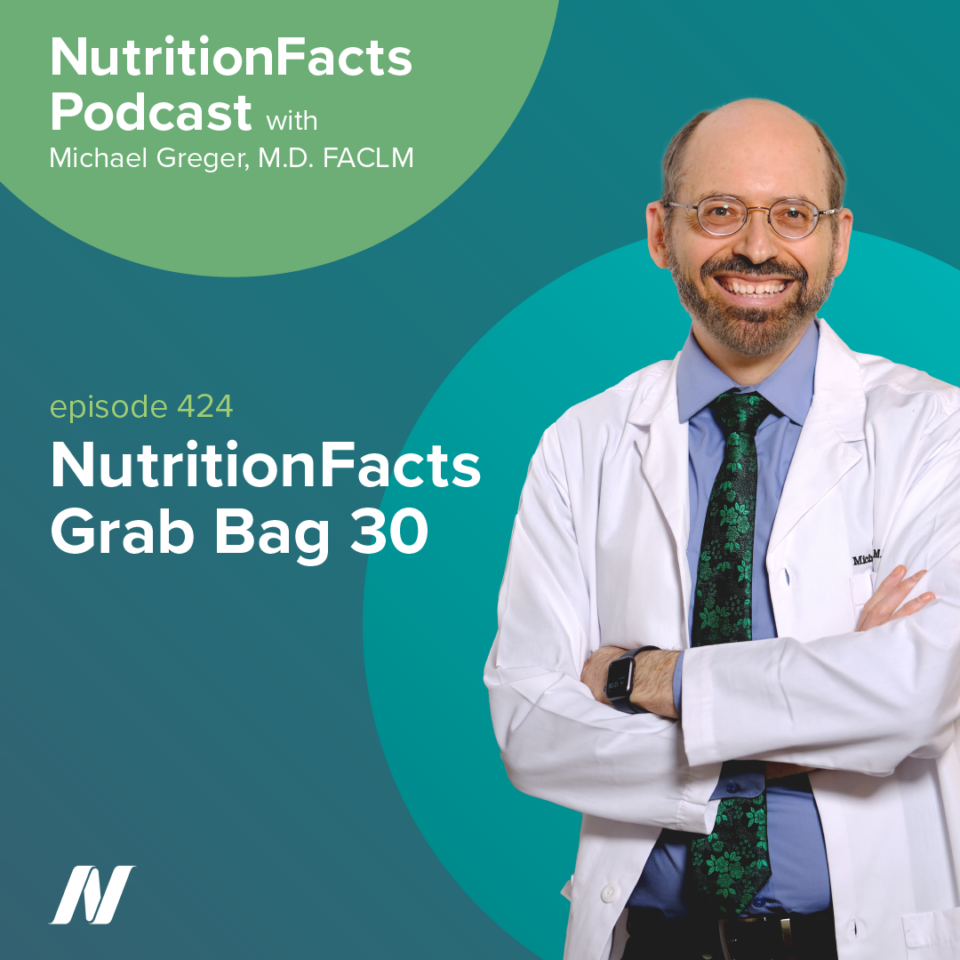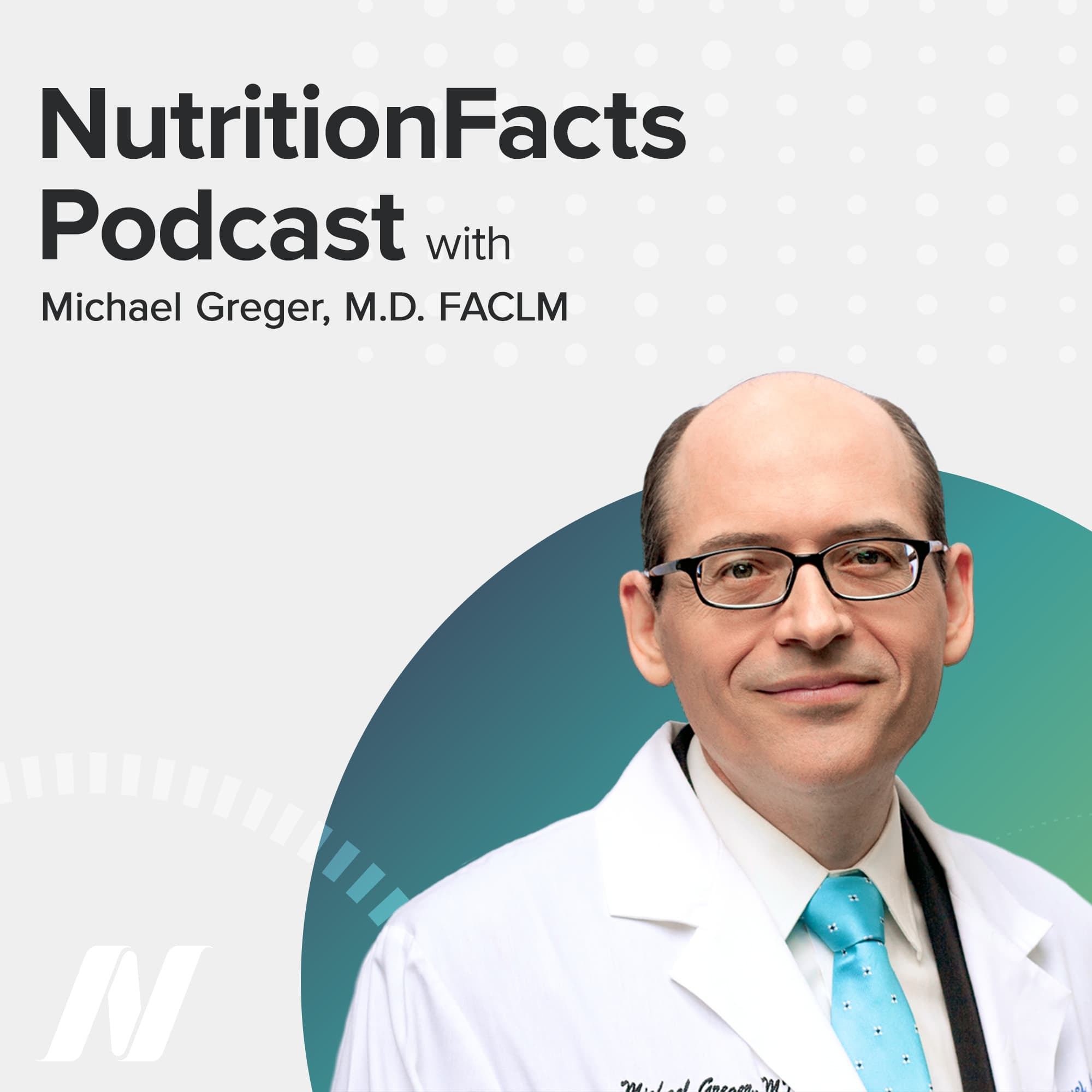Back by popular demand, it’s the NutritionFacts Grab Bag, where we look at the latest science on a whole variety of topics. And we start with a story on the FDA-approved bioidentical hormones that skirt the standardization concerns of compounded preparations.
The news that menopausal hormone therapy had the potential to cause higher rates of breast cancer, cardiovascular disease, and overall harm rocked women and physicians across the country. The study arm used progesterone and Premarin, because it was the most commonly prescribed form of estrogen, and is still prescribed more than a million times a year in the U.S. It’s a mixture of more than 50 different estrogens from horse pee. (“Premarin” comes from the words “pregnant mare urine”—if you’re skeptical, try crushing a pill and sniffing it.)
The dour findings of the Women’s Health Initiative (combined with some high-profile celebrity endorsements) saw interest shift to “bioidentical hormones,” made from plants rather than a horse source. They are marketed as being safer and more effective. No wonder estimates peg the annual number of prescriptions at 30 million a year, constituting a billion-dollar industry.
One reason patients may believe compounded hormone therapy is safer is that, thanks to a legal loophole, they are not mandated to provide the FDA insert required for commercial products warning about side effects. Purchased at regular pharmacies, hormones have a prominent black box with an all-caps “WARNING: ENDOMETRIAL CANCER, CARDIOVASCULAR DISORDERS, BREAST CANCER, AND PROBABLE DEMENTIA.”
There’s no evidence that bioidentical hormones are any safer, but the missing laundry list of side effects may give patients a false sense of security. Another appeal is customized dosing based on saliva hormone testing. But such tests are considered to be unreliable and so recommended against, since the only people who profit are the ones trying to sell you the tests.
Custom-compounded hormones are not FDA-approved, have not been shown to be safer or more effective, and may lack standardization of quality, purity, and dose. When the FDA or muckraking journalists have filled the same prescriptions in compounding pharmacies in different states, a third of the stated estrogen contents were off, by as much as 250 percent. No wonder all the major American medical societies that counsel physicians on treating menopausal women recommend against compounded hormones, including the American College of Obstetrics and Gynecology, the Endocrine Society, and the North American Menopause Society. Characterizing the pushback they got from their 2020 review recommending against the use of bioidentical hormones, the National Academies of Sciences, Engineering, and Medicine concluded, “It is clear from these communications that many clinicians, compounding pharmacists, and patients hold minimum, if any, concerns regarding the medication’s safety and effectiveness.”
Now, as of 2019, there are pee-free FDA-approved bioidentical hormones that skirt the standardization concerns of compounded preparations, but that just brings us back to square one, since they are considered to have the same risk/benefit profile. The multibillion-dollar compounded hormone industry is considered a “leading source of disinformation,” but the same could be said of Big Pharma. With so many billions of dollars at stake, it’s hard to know who to trust. When in doubt, I turn to The Medical Letter on Drugs and Therapeutics, considered one of the least biased sources in medicine. It’s kind of like the Consumer Reports of the drug world—and, in fact, was actually co-founded by the co-founder of the publisher of Consumer Reports more than 50 years ago. As The Medical Letter used to brag on their website, it “does not accept grants—from any source; donations—from anyone; [or] funding—from any entity.”
They won’t let their work be used for promotional purposes, and they don’t accept any advertising. In their review of the evidence, they concluded, “There is no acceptable evidence that bio-identical hormones are safer.”
So, how do you treat menopausal symptoms like hot flashes? The American College of Obstetricians and Gynecologists suggests palliative measures, such as “consuming cool drinks.” But is there really no way to treat hot flashes without the cancer, clots, and coronaries? Thankfully there is, as I cover in a video series that starts with Menopausal Hot Flashes Are Not Inevitable, and then moves from prevention to treatment.
In our next story, we look at how laser therapy is marketed as a promising alternative to drugs and scalpels for treating hair loss. But does it work?
In my book, How Not to Age, I discuss all the drugs, foods, supplements, and surgeries that can treat age-related hair loss. But what about non-dietary, non-drug, non-surgical interventions? Autologous platelet‐rich plasma, where concentrated portions of your own blood is repeatedly injected into your scalp, appears to have an efficacy similar to the available drugs, though the available evidence is considered insufficient to recommend it, and so remains unapproved in the U.S. or Europe for hair restoration purposes. Scalp Botox is also not recommended. The thought was that relaxing scalp muscles might improve blood flow, but when actually put to the test, actually caused hair loss in some pilot study participants. Then, there are lasers.
In the 1960’s, a Hungarian physician published the paper “The effect of laser beams on the growth of hair in mice,” detailing a serendipitous discovery that a low-powered ruby laser increased the hair growth on the shaved backs of mice. The mechanism appears to be increased blood flow. The floodgates opened when the FDA cleared the first low-level laser therapy device for age-related pattern hair loss in 2007, and now, there are clinics advertising lasers for everything from tennis elbow to “scrotal rejuvenation.”
There have been at least ten randomized, controlled trials of low-level laser therapy devices for hair loss, and the efficacy has been found comparable or even superior to the drugs. They are non-invasive, and appear to be relatively safe. Mild side effects include itching, acne, and scalp tenderness that usually resolve within two weeks. Reviews typically conclude that laser therapy may be a promising alternative to drugs and scalpels, but there remains considerable skepticism within the dermatology community, and for good reason.
Most of the laser therapy trials were funded by the manufacturers of the tested products themselves. This is true of hair loss treatments across the board, but laser studies appear particularly reticent to provide visual evidence or inquire about perhaps the most important outcome of all: patient satisfaction. When the first independent study was performed, blinded evaluations of before-and-after photographs could not detect a difference in hair density or caliber. In two studies that compared subjective satisfaction between laser and sham placebo devices, no significant difference could be found either. In other words, from the patient’s perspective, they just plain don’t work. So, while there are statistically significant improvements in hair density and thickness, there may be little clinically significant improvement.
If you want to give them a try anyway, there are at least 29 FDA-cleared devices currently on the market. There have been no head-to-head studies between them, but based on measured outcomes, there appear to be no difference between comb-style and hat-style devices––though those containing laser diodes exclusively may have an edge over devices that include a mix of both laser diodes and LED. Do not look into the light, as prolonged retinal exposure could be damaging. Thankfully, at least most cap designs have a built-in safety shut off to avoid accidental eye exposure. Otherwise, besides general safety caveats about using electrical contraptions in or around water, such devices are considered safe, though they are contraindicated for those with cancer of the scalp due to the potential for stimulatory effects.
Finally today, we hear about Astralagus root, one of the most popular herbs in traditional Chinese medicine that is marketed as a “life-prolonging” tonic. What does the science say?
In 2008, it was reported that a screening of traditional Chinese medicine plants identified a compound called cycloastragenol in the roots of the astragalus plant that appeared to moderately enhance telomerase activation. That’s an enzyme I’ve covered before that our body uses to try to reverse one aspect of cellular aging by elongating your telomeres, the protective caps on your chromosomes. Three years later, after it was shown to elongate short telomeres and improve healthspan (though not lifespan) in mice, a one-year human trial was published.
Although in most of the subjects, telomeres continued to shorten on average, there did seem to be a significant reduction in the proportion of cells with critically short telomeres. And the side effects looked good, including a drop in LDL cholesterol and blood pressure. But, there was no control group and cycloastragenol (branded as “TA-65”) was but one of over fifty vitamins, minerals, herbs, and other compounds they gave to the research subjects that year.
When TA-65 was finally properly put to the test in randomized controlled trials, there was no cholesterol or blood pressure benefit whatsoever. But in cytomegalovirus-positive patients, a significant telomere-lengthening effect was demonstrated at one dose, but not another. (Those with chronic viral infections, such as CMV or HIV, tend to have white blood cells with especially truncated telomeres.) The only such study showing clinical benefit was a year-long pilot study of TA-65 for early age-related macular degeneration, though it was funded by the company that sells it for $600 a bottle. They grossed more than $50 million before the Federal Trade Commission charged them with false and deceptive claims and practices.
That $600 buys you less than a gram of astragalus root extract. You can buy astragalus root extract in bulk 50,000 times cheaper for less than $20 a pound, should there ever be independently-verified benefits. Astragalus root, well-known as huáng qí in China, is one of the most popular herbs in traditional Chinese medicine, included in hundreds of herbal formulas and evidently widely marketed for millennia as a “life-prolonging” tonic. No data on that, but about 30 grams a day appeared to help with a type of autoimmune kidney disease called idiopathic membranous nephropathy in 50 randomized controlled trials, but not placebo-controlled trials. So, any placebo effects can’t be discounted.
Pregnant or nursing women are cautioned against using astragalus, and a theoretical concern was raised that it may activate a certain oncogene, a potentially cancer-causing gene. However, dozens of randomized trials of astragalus-based herbal preparations as an add-on therapy to chemotherapy for the most common type of lung cancer (non-small-cell) found, if anything, astragalus to be protective. Lung cancer is the leading cause of cancer death in the U.S. Adding astragalus to standard platinum-based chemo reduced the risk of death as much as 38 percent at the one-year-mark, and 25 percent at two years. However, in almost all trials, the astragalus was just one of many herbs used in a formula, making the effects of astragalus impossible to tease out. And, unfortunately, publication bias is widespread in the traditional Chinese medicine literature, where inconvenient results may be quietly shelved––though this in no way unique to that field.
Similar remarkable results, with similar critical caveats, were published for astragalus-containing formulas for colorectal cancer, including improved quality of life. Same with cervical cancer, with remarkably-reduced chemotherapy toxicity: less nausea and vomiting, less hair loss, less nerve damage, and less liver and kidney toxicity. Also, less lung damage from radiation treatments, and, for stomach cancer, improved quality of life and quantity of life.

 Previous Podcast
Previous Podcast Next Podcast
Next Podcast